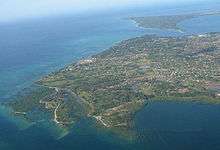Please tell us which country and city you'd like to see the weather in.

Mtwara Port
The Mtwara Port was built during the British Colonial times in the city of Mtwara in southern Tanzania. The harbor at the Port of Mtwara was deepened during the colonial times by the British in 1948-1954, and railway line was built connecting the port, as part of the Tanganyika groundnut scheme. Due to the failure of the scheme the port immediately lost value and the railway line was removed. The port was functional but underutilized for many years due to poor transport infrastructure, However, in the years of 2010-2011 the increased activity in oil and gas exploration activity caused a surge on operations. The Mtwara port is also an integral part of the Mtwara Development Corridor project and has recently saw major upgrades. The port also has a special economic zone attached to it and In December 2015 Alistair Freeports Limited injected $700,000 to upgrade the Export processing zone around the port area.
Operations
The port has historically handled very little cargo due to the lack of large industries in the area. The major export out of the port has always been cashew nuts. The Port has a quay wall of 385m and can handle two ships and one ocean ship at once. Previously the port could only handle ships of length up to 175m however with recent renovations in 2015, the ship handled a 209m ship in February 2015. The port handles 400,000 metric tonnes of cargo annually and constitutes to less than 5% of the total countries cargo movement, however, the government plans to upgrade the port drastically to facilitate trade in the southern part of the country.

Mtwara
Mtwara (Portuguese: Montewara) is the capital city of Mtwara Region in southeastern Tanzania. In the 1940s, it was planned and constructed as the export facility for the disastrous Tanganyika groundnut scheme, but was somewhat neglected when the scheme was abandoned in 1951. The city is spread out over a large area planned to accommodate up to 200,000 people. The present population is around 80,000. As part of the development associated with the failed Tanganyika groundnut scheme, Mtwara features a deep-water port that can accommodate ocean-going vessels, and a range of large municipal buildings, including a post office. Recent improvements in the port made it possible for big container ships to berth there.
Transportation
Mtwara has reasonable transport links considering its remoteness in southern Tanzania. It is linked by paved roads with Dar es Salaam and Lindi to the north and Masasi inland and by partially paved roads to Newala in-land to the west. Beyond Masasi the road is newly paved for some 60 km towards Tunduru and the Unity Bridge which provides a crossing point to Mozambique. The A19 links it with Mbamba Bay on Lake Malawi in the west. It features an airport with a paved runway that can accommodate medium size passenger jets. Precision Air runs a daily morning flight between Mtwara and Dar es Salaam and Air Tanzania offers a flight in the afternoon. The flight time is around an hour. Facilities for landing do not allow for planes to use the airport when it is hidden in mist. Mtwara serves as the access point for a small but growing tourism industry based in nearby Mikindani. New roads of a good standard were being built in 2013 within the city. Most of the roads have never been sealed. There is a choice of bus companies which provide daily services between Mtwara and Dar es Salaam. Also regular buses connect with Masasi, the biggest town inland from Mtwara.

Mtwara Region
Mtwara Region is one of Tanzania's 30 administrative regions. The regional capital is the municipality of Mtwara. According to the 2012 national census, the region had a population of 1,270,854, which was lower than the pre-census projection of 1,374,767. For 2002-2012, the region's 1.2 percent average annual population growth rate was the 26th highest in the country. It was also the fourteenth most densely populated region with 76 people per square kilometer.
The boundary with Mozambique to the south is formed by the Ruvuma River. To the west, Mtwara is bordered by Ruvuma Region, to the north by Lindi Region, and to the east is the Indian Ocean.
Development of the Mtwara Region has been constrained by the lack of highway and energy infrastructures. The Dar es Salaam-Kibiti-Lindi-Mtwara road has been improved by the completion of the Mkapa Bridge over the Rufiji River. Mnazi Bay gas promises to provide reliable and adequate electricity for powering industrial and commercial activities in the region.
Podcasts:

